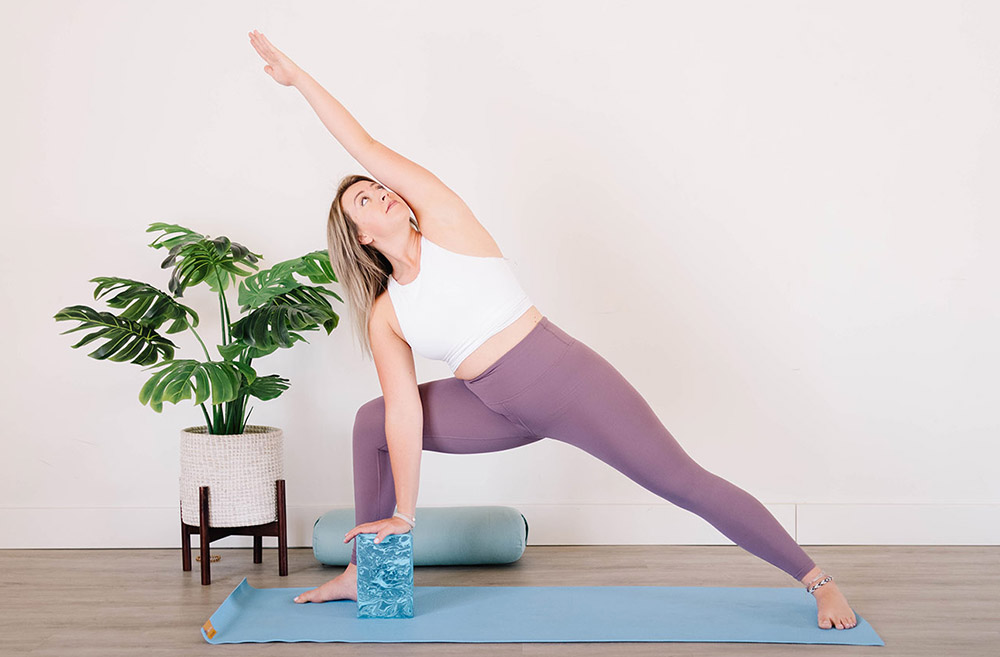
Last weekend I guest taught for a local yoga teacher training. In the 300-hour training, I gave a talk on Iyengar Yoga and offered thoughts and practices on keeping the sacroiliac (SI) joint healthy and intact. I spoke about one of my favorite subjects: avoiding squaring the hips in standing poses. This evolved into a deep discussion of the importance of maintaining beginner’s mind.
Squaring the hips in standing poses is an instruction that was widely taught long ago, in the early ears of my practice—before many of us knew better. Even now, 20 years after many of us old-timers discovered that squaring the hips is not conducive to healthy practice, the instruction persists. Almost everyone in the teacher training had been told to do this at some point in their practice.
When I first began teaching in 1986, I regularly tugged on people’s pelvises to try to make their hips square. Invariably, this would cause the knee of the other leg to misalign. So I’d have to pull on that as well. I should have taken this as a sign. If squaring the hips caused misalignment elsewhere, maybe it wasn’t such a great idea.
Still, I stuck to what I’d learned. Every teacher I’d studied with taught this, and I trusted them. It wasn’t until I began exploring not squaring my hips that I discovered how much better my standing poses felt when I abandoned that instruction. By that time, a whole lot of other teachers had begun to rethink it as well.
Take a moment to read this post on squaring the hips, so you’re up to speed as to why it’s not a great idea.
Keeping a Beginner’s Mind
It’s important to remember that when a teacher tells you to square your hips in standing poses, they’re doing it because it is the best information they have at the moment. No doubt they learned it from another competent teacher. No one is trying to cause hip and SI joint problems by giving that instruction. In fact, they are trying to do what is right, according to their training.
But being a teacher requires that we continue to be a student as well. No matter how much you love and trust your mentors, inquiring into what they tell you is crucial. Your best teaching will come from your own observations. And those observations come from keeping a beginner’s mind.
In Suzuki Roshi’s classic book, Zen Mind, Beginner’s Mind, he writes:
“In the beginner’s mind there are many possibilities. In the expert’s mind there are few.”
In order to keep our practice and teaching fresh, we must continue to learn. It means we need to keep an open mind about alignment “truths” that we hold dear, no matter how many times we’ve taught them. A beginner’s mind allows us to open to what is really true, not simply what we believe to be true.
B.K.S. Iyengar had a well-deserved reputation for being gruff and insistent about his alignment ideas. But if, in his practice, he discovered a better way to align himself, he’d drop long-held alignment instructions in favor of his new understanding.
I admired this quality. Iyengar was a highly influential teacher for 70 years. Yet he maintained a beginner’s mind. His daily practice was his teacher. He was not afraid to completely throw out something he may have insisted upon for years.
Know Your Intentions—and Stay Open
At the end of the training last weekend, some of the trainees lamented that they’d been cueing “square your hips” in their classes. I, too, have often regretted giving that instruction. Even more, I regret pulling and tugging on people to try to force them to square their hips. And that’s not the only thing I taught early on that I’d like to take back!
But I know that my intentions were to follow what I thought was in my students’ best interests. I’m guessing there’s not a yoga teacher alive who hasn’t taught something that they later found was not optimal. We all start wherever we are, with the best information we have. I have no doubt that I’ll learn new truths as my practice continues. That may require me to toss old ideas, and that’s a good thing.
Trust your intentions, but maintain a beginner’s mind. This will keep your practice and teaching fresh. And you may discover something that transforms your and your students’ practice.
